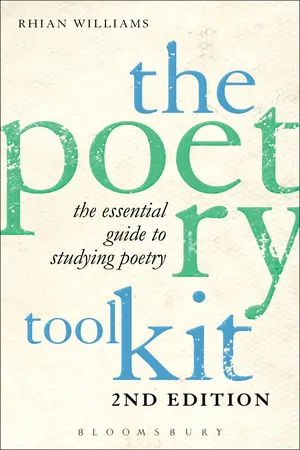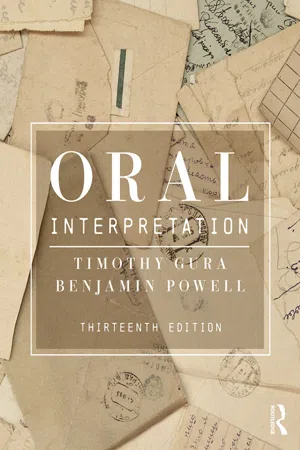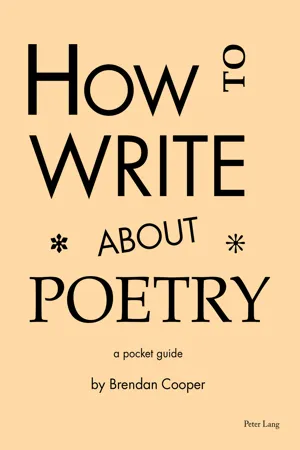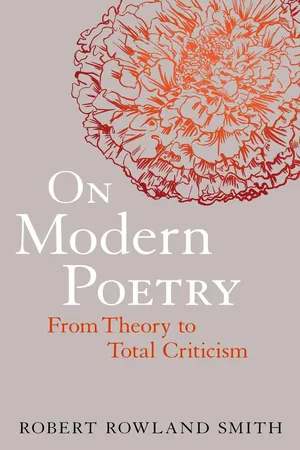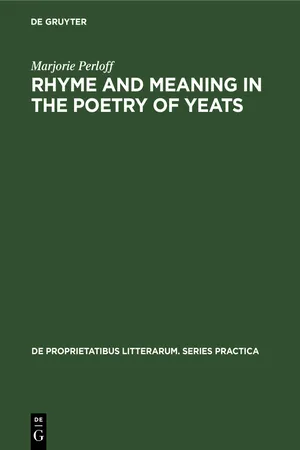Literature
Rhyme Scheme
Rhyme scheme refers to the pattern of rhymes at the end of each line in a poem or song. It is typically represented using letters to indicate which lines rhyme with each other. For example, a common rhyme scheme in a quatrain might be ABAB, indicating that the first and third lines rhyme with each other, and the second and fourth lines rhyme with each other.
Written by Perlego with AI-assistance
Related key terms
1 of 5
9 Key excerpts on "Rhyme Scheme"
- eBook - PDF
- Rhian Williams(Author)
- 2013(Publication Date)
- Bloomsbury Academic(Publisher)
The trajectory that the poem ultimately charts – from naïve idealism and hope to jaded damage and despair – is then devastatingly predicted in the eye rhyme between ‘wreath’ and ‘death’, which turns the abundance of springtime blossom to an autumnal funereal bower. 4.4 Rhyme Schemes Rhyme Scheme The ordered pattern of end-rhymes across a poem. We have seen rhymes, both perfect and imperfect, appear across poetic lines and they even feature in free verse or unrhymed blank verse , but rhyme is especially associated with patterned line endings. When this occurs these formal arrange- The Poetry Toolkit 178 ments are marked or noted in a ‘Rhyme Scheme’, which allows us to see a poem’s larger pattern of rhymes and to sense various dynamics within the poem itself. Rhyme Schemes might be dictated by tradition, or they may be devised by an individual poet. To identify a rhyme-scheme take a poem and give a letter, in alphabetical order, to each different sound you hear at a line end. So, label the first line-end sound with ‘a’ and then label any subsequent repeats of that sound also with ‘a’. Give the next different line-end sound a ‘b’, together with subsequent occurrences of that sound, and so on. The pattern that emerges can then be described in shorthand as ‘ a-b-b-a ’ or ‘ a-b-a , b-c-b , c-d-c ’, or whatever. Line ends that don’t rhyme with any of the other sounds in a regular poem are labelled ‘x’ to indicate ‘no rhyme’. As discussed in the case of the sonnet , rhyme-schemes can be associated with particular traditions (so the quatrains of a Shakespearean sonnet have ‘ a-b-a-b ’ rhyme-schemes). This is particularly relevant to stanza forms, as will be discussed in the next chapter. However, Rhyme Schemes can be vital to poems not written in stanzas. Here rhyme patterns may be repeated, even if that repetition is not emphasized in clear breaks on the page. - eBook - ePub
- Timothy Gura, Benjamin Powell(Authors)
- 2018(Publication Date)
- Routledge(Publisher)
As is true of what you learn from scansion, what you discover from studying cadence has a direct input into your rehearsal. If, say, you choose to perform “Open the Gates” (by now, you know a great deal about how that poem works), you can embody and evoke this knowledge. Specifically, what rate will you select for the first stanza? Of course, your decisions about where to pause will be guided by what you discover in secondary cadences. Will you simply repeat the same choices in stanza 2? Why not? And, as you approach line 8, how will you negotiate the dangerous phrases in “I brandish the great bone of my death” so that you prepare listeners for “Beat once therewith, and beat no more”? The last two lines are the longest in the poem. Are they rushed to finish the poem off, or paced more deliberately to show the final, appalling sight that confronts the speaker? If you hadn’t discovered this in analysis, would you have intuitively made all the appropriate decisions in performing this poem? Analysis provides you with certain wisdom. In the tumult of anxieties that attends any performance, such certainty is a rock on which interpreters gladly rest.Clearly, no audience will ever grasp fully the subtlety of this rhythmic pattern when the poem is read aloud. Indeed, it would be most unfortunate if you called attention to the pattern. Nevertheless, unless you understand what the poet has done to communicate the total effect, your audience loses.Rhyme
Rhyme most commonly occurs at the line ends. Lines may contain internal rhymes as well. Unlike rhythm and cadence, rhyme is not an essential element of poetry—some fine poems have very little rhyme. But when it occurs it can reinforce rhythm, cadence, pattern, and tone color.Although corresponding sounds strike the mind’s ear in a silent reading, they emerge for complete appreciation only when a poem is read aloud. Like a chime of music, rhyme is satisfying and pleasing to hear; it gives intellectual pleasure through the delights of repetition and anticipation. The reason for rhyme, however, is not to decorate a poem but rather to bind it more closely together. For one thing, rhyme unifies the pattern of sound. Its power doubtless contributes to the explosive popularity of rap music and hip hop. Can you imagine either without rhyme? Just as in more traditional poetry, rhyme emphasizes the line lengths by creating an expectation of repeated sounds at regular intervals. Experienced poets and rap artists know that rhyme, if used unwisely, can shatter rather than intensify the unity of a poem. Therefore, when they use rhyme, they exhibit great care and ingenuity in handling it. It’s a powerful tool so you need to use it carefully. If you stress every rhyme, the aural shape of the poem blocks out all of its other qualities. Now for some more terms.Rhyme is the exact correspondence of both final vowel and consonant sounds (love—dove). There are several kinds of rhyme. Assonance is the correspondence of vowel sounds only, regardless of the final consonant sounds (place—brave). In half rhymes (pavement—gravely, river—weather - eBook - PDF
How to Write About Poetry
A Pocket Guide
- Brendan Cooper(Author)
- 2019(Publication Date)
There are various dimensions to this notion of the shaping or arranging of words, and the first one I wish to explore is especially well known – familiar to pretty much everyone, in fact, right from their very earliest experiments with language and sound patterns as young children. This is the phenomenon of rhyme. 36 Chapter 3 The Reasons for Rhyme Not all poems rhyme. No one says that they must. Back in the seventeenth century, John Milton was already rebel- ling against the presence of rhyme in English poetry; he rather dismissively described it as “the jingling sound of like endings, a fault avoyded by the learned Ancients both in Poetry and all good Oratory”. Since the beginning of the twentieth century, in particular, many poets have tried to avoid a reliance on rhyme in favour of more innovative and original methods. Nevertheless, rhyme remains one of the most conspicuous features of poetry, one of the easiest, clearest ways that a poem becomes identifiable as a poem. However, the question of why poets use rhyme – of its purpose, its effect – is not so commonly considered, and not so straightforward. Simply pointing out that a poem either rhymes or does not rhyme does not get us very far. We need to consider carefully the reasons why rhyme might be used, the effect it creates when it appears, and the best possible ways to approach the analysis of rhyme in poetry. So, why rhyme at all? The use of rhyme is related to long-held connections between poetry and song. Rhyme is, effectively, a form of music. It is the chiming of word- sounds together, and as such, it might be fair to say that moments of rhyme are where language is at its most musi- cal. The potential effects of rhyme, though, are somewhat complicated and unpredictable. These can vary greatly, often depending on the overall tone or subject matter The Challenge of Poetic Form 37 of the particular poem. Rhyme often seems to reflect or reinforce elements of a poem’s overall message. - eBook - PDF
On Modern Poetry
From Theory to Total Criticism
- Robert Rowland Smith(Author)
- 2012(Publication Date)
- Continuum(Publisher)
On top of the narrative, however – or underneath it – we have the original rhyme (letter/ better) along with a rhythm considered as a pattern of beats (two lots of four iambs, each with a soft ending in an extra beat). How do they work together, and in what sense do they create any meaning extra to that we can extract thanks to our interpretations? A rhyme is not intrinsic to the narrative, so in what sense can it contribute to any kind of meaning, especially as it is semantically null? The first point to underscore is that, in poetry at least, rhyme without rhythm isn’t rhyme; it is just a list of words that match. Rhyme is a rhythmic matching, and rhythm can’t work without temporalization and spatialization, which are effectively the same. Rhythm s/paces out the words in a poem in a pattern; when that pattern incorporates words at the end of two or more lines that match, the rhythmic poem rhymes. And so, by slotting the matching words into the end of certain lines, rhythm controls the profligacy of rhyme. It tells us which words are to be taken as matching – those at the end of the line – and to ignore matches that pop up elsewhere (let’s set aside internal rhymes for now). It maps the architecture of the poem in terms of where the weight is distributed; and because rhyme/rhythm operate on patterns, the distribution is typically regular. Whence the second order ‘meaning’ that the rhyming poem achieves. I put meaning in quotation marks because the meaning that results from rhythm has less to do with semantic content than with that sense of architectural distribution. The poem becomes meaningful in so far as it has followed architectural convention, planting words according to a template or pro forma that is meaningful mainly by virtue of its recognizability. - Editors of REA(Author)
- 2012(Publication Date)
- Research & Education Association(Publisher)
The most common is the end rhyme, which has the rhyming word at the end of the line, bringing the line to a definite stop but setting up for a rhyming word in another line later on, as in “Stanzas”: home… Rome, a perfect rhyme. Internal rhyme includes at least one rhyming word within the line, often for the purpose of speeding the rhythm or making it linger. Look at the effect of Byron’s internal rhymes mixed with half-rhymes: “combat… for that”; “Can/And… hanged” slowing the rhythm, making the reader dwell on the harsh long “a” sound, prolonging the sneer which almost becomes a snarl of anger. Slant rhyme, sometimes referred to as half, off, near, or approximate rhyme, often jolts a reader who expects a perfect rhyme; poets thus use such a rhyme to express disappointment or a deliberate let-down. Masculine rhyme uses one-syllable words or stresses the final syllable of polysyllabic words, giving the feeling of strength and impact. Feminine rhyme uses a rhyme of two or more syllables, the stress not falling upon the last syllable, giving a feeling of softness and lightness. One can see that these terms for rhyme were written in a less enlightened age! The terms themselves for the rhymes are less important than realizing or at least appreciating the effects of the rhymes. If the lines from “Stanzas” had been unrhymed and varying in metrical pattern, the verse would have been termed free, or to use the French term, “Vers libre,” not to be confused with blank verse, which is also unrhymed but has a strict rhythm. The Elizabethan poets Wyatt and Surrey introduced blank verse, which Shakespeare uses to such good effect in his plays, and later, Milton in the great English epic Paradise Lost. Free verse has become associated with “modern” poetry, often adding to its so-called obscurity because without rhyme and rhythm, poets often resort to complicated syntactical patterns, repeated phrases, awkward cadences, and parallelism- eBook - PDF
Roots of Lyric
Primitive Poetry and Modern Poetics
- Andrew Welsh(Author)
- 2019(Publication Date)
- Princeton University Press(Publisher)
The roots of meter, he felt, lie in those external rhythms that have always been used to form language to the measures of music: The rhythmic form of verse is the same in its essential principles as that of the music of song, from which it is, in fact, derived in the first instance. In some kinds of verse, it is true, the form is much more remote from that of song than in others. For example, our English blank verse and the French Alexandrine line have been made, more or less deliberately, as unlike song as verse can ever be; and indeed all verse meant to be used in long poems or to be spoken in anything like the level of tone of prose discourse must have been treated in the same way. Still, the changes that have been intro-duced into our spoken verse, as we may call it, have not affected the fundamental principles of rhythm which it derives from song; they are merely additional procedures which restrict the operation of these prin-ciples within certain limits, without changing them in any way or adding new ones to them. Meanwhile a great deal of poetry continues and will always continue to be made as much like song as possible. Dancing and R H Y T H M music are the arts of rhythm; they have nothing to learn about their own business from poetry; poetry, on the other hand, has derived all it knows about rhythm from them. The best way to approach the study of the rhythm of verse, therefore, is by way of the form of song. 1 Poetic meter is seen here as fundamentally musical meas-ure, and it is best notated by time signatures, bar lines, notes which indicate syllable duration, and rests. Both versions of poetic meter recognize that a metrical pattern does not tell us the whole story of the rhythm in a line of poetry. In fact, the most valued effects of meter in poetry occur not when the language corresponds with docile regularity to the metrical pattern, but on those oc-casions when rhythms in the language challenge and con-flict with that regular pattern. - eBook - ePub
- Mick Short(Author)
- 2018(Publication Date)
- Routledge(Publisher)
But another factor which reinforces this division into two halves is that the rhythmic spacing coincides with an important grammatical boundary within the structure of the sentence. The first half is the subject noun phrase of the sentence, and the second is what is said about it (the predicate). In other words, the rhythmic division into two halves reinforces the basic subject-predicate structure of the sentence. This helps us to see that interesting rhythmic effects in English can be created by varying the way in which units at other linguistic levels (e.g. word structure, grammatical structure) relate to the groupings of strong and weak stresses. Compare, for example, your 'tapping out' readings for A rolling stone gathers the moss with the following two sentences, each of which also has eight syllables: (i) A rolling stone obliterates (where the last word has four syllables and you are likely to perceive two rhythmic beats within it, one on —blit— and one on — ates, to preserve the 'two-halves' structure coinciding with the subject—predicate division) and (ii) A large rolling boulder totters (where the subject—predicate division no longer coincides with the middle of the sentence, giving rise to two ways of 'reading' the sentence, one with a division after rolling, which emphasises the 'two—halves' structure, and one with a division after boulder, emphasising the subject-predicate structure). 5.3 Metre Poetry has more marked, and more complex, rhythmic effects than ordinary language because it has an extra layer of rhythmic structuring, which is usually called metre. As we will see below, this level of rhythmic structuring is indicated by the fact that lines of poetry, unlike prose, do not extend out to the right-hand edge of the page. Because the possession of metre is one of the basic ways in which poetry can be distinguished from prose, it will be important to examine it in some detail - eBook - PDF
- Marjorie Perloff(Author)
- 2019(Publication Date)
- De Gruyter Mouton(Publisher)
This stanza has eight lines and six rhymed lines, since all but the first two lines end with a rhyming unit. There are two instances of epiphora, lines 1 and 2 both ending with the word shade. The stanza contains three rhymes: cloth/ path, breath/ death, and summon/ -human. Of these three rhymes, two are approximate: cloth/ path and summon/ human. Table A also gives a brief description of the Rhyme Scheme and meter of each poem. No attempt is made here to establish an accurate classi-fication of Yeats's verse forms; 8 the Table merely provides a general idea of Yeats's versification, with particular reference to the type of rhyme alternation and the length of the intervals between rhymes. As Table A indicates, Yeats uses an astonishing variety of verse forms. Every possible Rhyme Scheme is explored, while the meters range from the di-meter of A Cradle Song (26) 7 to the heptameter of The Indian upon God (6). The most common Rhyme Scheme is CROSS-RHYME, 8 used with a variety of meters. The Dolls (147), for example, is in trimeter cross-rhyme, To a Wealthy Man (121) in tetrameter cross-rhyme, and To Dorothy Wellesley (345) in pentameter cross-rhyme. QUADRATE RHYMING, 9 very common in Yeats's poetry of the 1890's, begins to disappear after 1900, although Yeats later employs an eight-line stanza, consisting of two quadrate rhyming units, abbacddc, for such 6 For an attempt at making such a classification, see Marilyn Denton, The Form of Yeats's Lyric Poetry, passim. 7 Throughout this dissertation, the number in parentheses following the title of a given poem by Yeats is the number assigned to that poem in the Variorum text. 8 CROSS-RHYME refers to the scheme abab; this type of quatrain is called a ballad quatrain if it is written in common ballad metre (a 4 b 3 a4b 3 ); it is called an heroic or elegiac quatrain when written in iambic pentameter. See Karl Shapiro and Robert Beum, A Prosody Handbook (New York, 1965), p. - eBook - PDF
- John Singleton, Mary Luckhurst, John Singleton, Mary Luckhurst(Authors)
- 2000(Publication Date)
- Bloomsbury Academic(Publisher)
The lines, and the groups, may be regular in one or another way, as in limericks and sonnets; or they may be irregular, creating a new form 164 WRITING VERSE 165 unique to that poem: but in all cases there is a form, so again the choice is not whether to have a form, but whether you attend to the form. Poetry has varied enormously over time (as you can see by paging through the Norton Anthology), and because people have often been taught poetry narrowly at school there are common misconceptions about 'what poetry is'. Before the twentieth century most poetry in English was written in regu-lar metres (or patterns of stress), so that each line has a similar rhythm; and in prescribed forms, so all the lines are either of the same length, or vary in a regular way. Poems of this kind often have a regular pattern of end-rhymes (called the Rhyme Scheme): but this does not mean that 'all poems rhyme', nor that 'if it rhymes it's a poem'; and in the twentieth century (especially since T. S. Eliot's The Waste Land [1922]: N1236) free verse (where the metrical pattern varies from line to line) and open form (where the line lengths and Rhyme Scheme are ir-regular) have become increasingly popular. There is still metre, and form: but they are freed from preset rules and limits. You may want to write more traditional poetry (and many poets, like Tony Harrison, have continued to use regular metres and forms), or you may want to experiment with free verse, but in either case you will need to understand metre and form, to make them regular or to control their irregularities. Metre and form are very general terms, and each can be subdivided in many ways (some of which are explored in the Workshop Writing and Writing On sections).
Index pages curate the most relevant extracts from our library of academic textbooks. They’ve been created using an in-house natural language model (NLM), each adding context and meaning to key research topics.
